The regime's recent offensive against the Islamic State aimed at clearing large parts of desert in Syria's Raqqa Governorate of Islamic State presence took a drastic turn when a counter-attack spread chaos and fear among the forces spearheading the offensive. Completely misjudging the impending danger and incapable of properly anticipating the Islamic State's counter-attack, the offensive collapsed and instead of capturing large swaths of territory, the remaining regime forces were forced on the defensive, eventually being beaten all the way back to their starting point. The outcome of the offensive came as a surprise to many, not in the least because its exact goals remained unclear for some.
While some were quick to state the offensive was an attempt to capture the Islamic State's capital Raqqa or even to reach the besieged garrison in Deir ez-Zor, the actual goal of the offensive was to capture Tabqa airbase and from there to move on to the actual town of Tabqa itself. Much of the confusion originated from the unofficial name tied to the offensive: ''To Raqqa'', which actually meant this offensive was only the beginning of regime operations in the Governorate of Raqqa rather than directly capturing Raqqa itself. If the attempt at capturing Tabqa would have proved successful, this would have completely cut off the remaining road connections to the Islamic State from the outside world, and allowed the regime to use Tabqa as a staging base for future operations into the Islamic State's heartland. Thanks to the ambitious nature of the offensive, it could be seen as a gauge indicating the measure to which regime forces are capable of coordinating after the severe transformations it has been forced to undergo in the previous years. This is especially true after President Bashar al-Assad
vowed to liberate 'Every Inch of Syria from Terrorism' in a speech adressed to Syria's parliament on the 7th of June, five days after the offensive had started.
The offensive appeared to have been timed perfectly to coincide with another major operation taking place against the Islamic State in Northern Syria. This offensive, carried out by the Syrian Democratic Forces (SDF), was aimed at capturing the town of Manbij and the nearby Manbij Pocket. Holding this region is absolutely crucial for the Islamic State, as losing it could also result in losing the last remaining road connection to Turkey. It was previously thought that the Islamic State would prove unable to commit sufficient forces to two entire different fronts so close to each other, but time would eventually show just how false this belief was.
While a successful conclusion of the offensive thus would have seriously hampered the Islamic State's capabilities to bring in supplies and foreign fighters via Turkey, not to mention the fact that cutting off the Islamic State's sole remaining road connection to Turkey in general would be a major propaganda victory for the regime, neither the current military situation on the ground nor the state of the regime's military allowed for such a zealous undertaking. In fact, one could argue that the very existence of this offensive in the first place rather than its catrastophic outcome is representative of the poor state of the regime and its armed forces.
The regime's intentions of taking the fight to the Islamic State rather than repelling and counter-attacking Islamic State offensives throughout Syria first became clear in early 2016, when the National Defence Force's (NDF) Golan Regiment arrived in the town of
Ithiriya, from where the offensive would later be launched. The area around the town would see sporadic engagements aimed at testing the Islamic State's capabilities and willingness to defend this area in the months that followed. This would later prove a catrastophic miscalculation, as the initial situation encountered around Ithiriya was in no way representative of the Islamic State's true strength and willingness to defend this important location.
Due to the sheer length of the front the Islamic State currently has to defend against a variety of factions, it can't commit large numbers of fighters to a particular location. This is especially true for the area around Ithiriya, which due to the flat terrain and lack of easily defended obstacles (such as towns and oilfields) is nigh on impossible to defend. Concentrating large numbers of Islamic State fighters here would be senseless, as they wouldn't have any location to fall back to when routed, forcing them to flee into the open desert as easy targets for chasing regime forces.
Instead, the garrison deployed around Ithiriya, defending the crucial Ithiriya-Raqqa highway, only consisted of a small contingent of Islamic State fighters. This contingent was beaten back by the regime's first 'probing offensive' in February and March, which was halted after the Islamic State launched a diversionary attack near Khanasir. As the Syrian Arab Army (SyAA), National Defence Force and Shiite militias stationed here proved incapable of handling Khanasir alone, all effort went into defending and later recapturing lost positions around Khanasir, effectively ending operations near Ithiriya.
![]()
![]()
It was only during May 2016 when large numbers of regime forces started arriving in Ithiriya, ultimately said to be totalling up to 5000 soldiers, although the actual number is believed to be slightly lower. This is when the first major problem came into being. As the five-year long war has starved the regime's military of equipment, supplies but foremost manpower, gathering such a large amount of soldiers can nowadays only be achieved by pulling several brigades, regiments and militias together. These are then supposed to act as a unified army, but the past five years have shown us that such 'unified' formations are usually extremely inefficient in their operations.
This is only worsened by the decentralisation of the Syrian military into the National Defence Force (NDF) and dozens of other large and small militias nowadays responsible for regime operations throughout the country. The large numbers of soldiers that defected from the Syrian Arab Army (SyAA) and the sheer ineffectiveness of what remained led to the partial dissolvement of the SyAA. Although the SyAA remained in control of the many bases littered throughout Syria, much of its remaining offensive capabilities were stripped and subsequently handed over to the various militias, with the NDF receiving much of the manpower and equipment. This practically meant the end for Syria's once prestigious mechanised brigades, previously boasting up to 2500 tanks.
While transferring manpower and equipment to various militias that were deemed more trustworthy and loyal to the regime appeared logical at the time, it ended up creating a whole host of major problems that could potentially spiral out control in the future. While the move was absolutely necessary for the survival of the regime, it showed that the army that was once estimated to be one of the most powerful in the Middle East was actually completely dysfunctional. The results of decades of sectarianism, corruption and bad management on every level became painfully clear, and had simply eroded the SyAA to the point of total inoperability.
![]()
While the creation of numerous small militias proved to be extremely successful, spawning various highly-motivated regiments standing their ground in most fights, the expansion of the NDF recreated the problems encountered with the SyAA on several occasions, and sometimes actually worsened them. The NDF was originally established with the aim of raising up units willing to defend their town or neighbourhood against incursions by rebels. Such NDF units were composed of armed locals tasked with manning checkpoints and patrolling their neighbourhood or town. In essence, it obeyed the pure definition of a militia in its founding days. With the partial dissolvement of the SyAA, the NDF further expanded and partially replaced the SyAA as the regime's army. New units were erected and existing ones expanded, now including everything from convictees, men that solely enlisted for money and soldiers using the original equipment from what was once the SyAA.
This meant that a militia once comprised of local volunteers now inherited soldiers and equipment from various SyAA units, and saw its tasks expanding from guarding neighbourhoods to undertaking offensives elsewhere and guarding towns, gasfields and other strategic installations on the other side of Syria. This meant that once highly-motivated men that enlisted to defend their neighbourhood against Sunni rebels could now be manning checkpoints in Sunni-dominated towns. As these men often enlisted with the sole reason of protecting their minority neighbourhood, they have zero interest in defending a Sunni-dominated town from rebels, leading to a situation that is very prevalant in Syria, where defending regime forces flee instead of defending their designated town because they see no personal benefit in holding it. This is why countries ordinarily employ armies composed of professional soldiers, which when undertaking operations don't base their actions on their private reasoning, but on the reasoning on the state it serves. These soldiers defend gasfields because they're ordered to, knowing that the continuing flow of gas generates income for the country, which will eventually help it win the war.
While this already renders large parts of NDF units combat ineffective for anything but manning checkpoints, the Syrian High Command made the crucial mistake of individually attaching armoured fighting vehicles (AFVs) to militias instead of letting them operate in pre-existing armoured formations, albeit attached to the NDF. This results in some NDF regiments consisting solely of individual components rather than a well-oiled machine of interconnecting units.
![]()
![]()
But perhaps the most serious problem with the different forces fighting for the regime is that some units have become so powerful that these are now essentially private armies. Many of these elite units consist mainly of Alawites originating from Syria's coastal region or minorities (mostly Druzes) and are extremely sectarian as a result. These units make up much of the regime's offensive capabilities, and received the largest share of Russian-supplied weaponry in the past year, including T-90s. The now infamous Tiger Forces, led by Suheil 'The Tiger' al-Hassan and Suqour al-Sahraa' (The Desert Falcons) are the best-known examples of these private armies, and appear to be neither under SyAA or NDF command, but rather taking orders straight from the Syrian High Command or President Bashar al-Assad. This means that if one of these two units operate alongside SyAA or NDF units, different commanders from different branches of the regime's military are issuing different orders while both pursuing the exact same objective. It does occasionally happen that either of the two units take command and issues orders to forces of other branches, but this creates a whole host of other problems as many of the (semi-)independent militias are anything but keen to receive orders from a different branch (which was indeed a common complaint heard during the offensive on Tabqa). This proved to be less of a problem at
Tadmur, where the Russian Armed Forces had considerable influence upon the whole operation.
Another not unimportant shortcoming in the regime's tactics is the fact that it constantly moves its most capable units (Suqour al-Sahraa' and the Tiger Forces) throughout Syria when another position is about to run over or has been run over, forcing either of the two units to abandon their current operations. This has led to a string of unfinished offensives costing precious fuel, equipment and manpower. This also applies to the capture of Tadmur (Palmyra), the capture of which would have been justified if it had been taken with the aim of further advancing towards the besieged town of Deir ez-Zor. But instead of chasing the Islamic State all the way to the gates of Deir ez-Zor, which would have proved to be relatively easy as there were no major Islamic State strongholds between Tadmur and Deir ez-Zor, the regime halted its operations after seizing Tadmur. As the town of Tadmur and its archaeological remains had little military value to the regime, its capture turned out to mostly part of a PR-stunt likely aimed at showing the world the Syrian regime and Russia were defeating terrorism in Syria.
![]()
While the SyAA and NDF have recently begun advancing in the direction of al-Sukhna, located in between Tadmur and Deir ez-Zor, the units participating in these assaults consist of poorly trained units operating a hodgepodge of equipment and arms. Although supported by the Russian Army, it recently took huge losses when an Islamic State vehicle-borne improvised explosive device (VBIED) managed to reach their positions,
resulting in the death of a Russian serviceman and large numbers of regime fighters. The large amount of time between the capture of Tadmur and renewed operations in this region gave the Islamic State plenty of time to construct defensive fortifications, and any serious offensive aimed at overtaking them would require the deployment of either the Tiger Forces or Suqour al-Sahraa'. Had regime forces advanced immediately they could've taken advantage of the fact that IS forces were routing with little order or coordination, and possibly break open the road towards Deir ez-Zor in one fell swoop.
This brings us back to the Tabqa offensive, where all of the points mentioned above in combination with a gross underestimation of the Islamic State's capabilities, poor planning, greatly exposed flanks and a lack of Russian support which was desperately needed to make such an operation succeed led to a veritable disaster.
The force tasked with capturing Tabqa airbase and the town of Tabqa itself consisted of no less than eleven different branches and factions out of three (technically four) different countries, comprising Suqour al-Sahraa', the Syrian Arab Army (further divided into at least two regiments, at least believed to have been part of the 4th Armoured Division), the Syrian Arab Air Force, the National Defence Force (further divided into the Golan Regiment and several smaller regiments), the Syrian Social Nationalist Party (SSNP), the Ba'ath Brigades, the Arab Nationalist Guard, the Republican Guard, Hizbullah, the Russian Army and the Russian Air Force, each operating its own tanks and equipment. In addition, the Syrian Navy Seals also took part in the operation, although it remains unknown under what branch this unit serves. No Shiite militias are believed to have taken part in the fighting, likely due to their preoccupation with holding the front in Southern Aleppo.
![]()
![]()
This force could call upon large numbers of tanks, artillery, multiple rocket launchers (MRLs), the Syrian Arab Air Force's (SyAAF) assets, including fighter-bombers and attack helicopers, the Russian Army's 291th artillery brigade operating 152mm 2A65 Msta-Bs and the Russian Air Force's (RuAF) Mi-24s forward deployed at
Kweres airbase. The composition of tanks used by the various branches and factions involved in the conflict give a clear image of the current state of the regime's military and the logistical nightmare in equipping each and every tank with the right type of ammunition and spare parts. Participating in the offensive were: T-90s, T-72Bs, T-72AVs, a T-72AV 'TURMS-T', T-72M1s, T-62 Model 1967s and T-62 Model 1972s, T-55As, T-55Ms and T-55(A)MVs and BMP-1s. Artillery support was in the hands of truck-mounted anti-aircraft guns, Syrian-manned 122mm D-30 howitzers and 130mm M-46 field-guns and truck-mounted 107mm MRLs, 122mm BM-21s, IRAMs and 220mm BM-27s. The Russian Army provided one battery of 152mm 2A65 Msta-B howitzers. Surprisingly, the Russian Air Force limited its support to several Mi-24s, leaving the SyAAF to provide fast jets for aerial support to the advancing troops. The SyAAF however remains incapable of providing the same degree of air support as the RuAF has been doing over the past year. The SyAAF's SA-342 and Mi-25 attack helicopters also made an appearance over the battlefield, but ended up seeing almost no use during the offensive. Whether this was due to a lack of coordination between the SyAAF and the forces on the ground or due to a lack of sufficient operational airframes in the area remains unknown.
![]()
![]()
Altogether, these units posed an impressive force on paper. While the aerial support provided by the RuAF and the SyAAF was not up to the same standards seen during the offensive on Tadmur, the largely flat terrain around Tabqa was a huge advantage to the regime, sharply contrasting the mountainous area surrounding Tadmur. The force was mobilised for the upcoming offensive on the 1st of June, which was launched a day later. Spearheading the offensive was Suqour al-Sahraa', which deployed its Russian-delivered T-90s, T-72Bs, GAZ Tigers, Iveco LMs and armoured Ural-4320s, along with Russian advisors. Behind Suqour al-Sahraa' came the rest of the force, with the more experienced units operating closer to Suqour al-Sahraa' than the poorly trained units operating in the back and flanks. This immediately proved to be a problem however, as communication between such large numbers of units taking part has to be excellent in order to advance at the same time, inform other units about possible incoming attacks and to coordinate a possible retreat. Communication between all units was completely inadequate however, which would eventually result in the catastrophic defeat.
Another major issue was the location of the offensive, which cut right through Islamic State-held territory alongside the Ithiriya-Raqqa highway. This left the main force exposed on two sides, leaving them extremely vulnerable to counterattacks. Additionally, the forces designated to protect these flanks were poorly trained and equipped. Although this was indeed a potential recipe for disaster, and source of worry for many following the offensive over the past weeks, the Islamic State efforts at flanking regime forces proved problematic, but ultimately not the reason for its actual defeat.
The offensive, launched on the 2nd of June 2016, made its way from Ithiriya through territory previously captured during February. The Islamic State had mined the road plentiful before the start of offensive, which would prove a nuisance for the regime forces early on, but grow perpetually more problematic over time. While some IEDs were carefully camouflaged or even
disguised as rocks, the
placement of mines often left much to desire. A map showing the strategic situation before the offensive can be seen below, including the territory previously captured East of Ithiriya back in February 2016. All maps by
Peto Lucem, click on them to enlarge.
![]()
The offensive had only been going on for two days before it was already hailed as a major success. Namely, it had managed to enter Raqqa Governorate, of high symbolic value for any major party fighting in the Syrian Civil War. Elements of the Syrian Arab Army (SyAA) and Syrian Arab Air Force (SyAAF) were kicked out of Raqqa Governorate just under two years ago, when fighters of the Islamic State captured
Division 17,
Brigade 93 and
Tabqa airbase, thereby completely ending the regime's presence in this part of the country.
The regime forces encountered only sporadic resistance in the first days, allowing it to further advance towards Tabqa airbase with relative ease. This has much to do with the terrain, which due to a lack of prominent terrain features or towns was extremely difficult to defend. The Islamic State deployed several T-55s, technicals, truck-based VBIEDs and artillery to counter or at least slow down the regime's advances, but these lone units made easy targets for the regime's superior firepower. The resulting battles saw the
destruction of one T-55, another example
captured intact, one 122mm BM-21
captured (originally captured at Shaer back in July 2014) alongside a
single 122mm D-30 howitzer, one seizure of a truck-based
VBIED, one BMP-based
VBIED and several technicals. Interestingly, the Islamic State also deployed several UAVs to the theatre, at least two of which were shot down by the use of 14.5mm ZPU-4s and 23mm ZU-23s.
[1][2]The contingent spearheading the offensive meanwhile captured the small settlement of Abu al-Elaj on the 4th of June. This is where the Islamic State made its first true stand and even attempted a counter-attack to take the village back after losing it. This would have cut the the road between Ithiriya and the contingent speadheading the offensive, showing how vulnerable the whole operation was. In spite of their efforts, Abu al-Elaj and its surroundings remained in regime control during the offensive.
![]()
The sighting of the first BMP-based VBIED on the 3rd of June, the driver of which was killed before coming in a range close enough to detonate its deadly payload, revealed a now familiar identification marking. This black square reads: الدولة الإسلامية - 'Islamic State', جيش الخلافة - 'The Caliphate Army' (Jaish al-Khilafa) followed by a unique serial number. While many thought this black square referred to the particular tank or VBIED being in service of an Islamic State unit called 'Jaish al-Khilafa', the black square is actually applied on any armoured fighting vehicle (AFV), including VBIEDs, overhauled by the Islamic State's armour workshop in Raqqa, whose conversions will be covered in a future article.
![]()
![]()
At least three BMP-based VBIEDs would be sent off against advancing regime forces during the course of the offensive. Remarkably, not one managed to actually detonate its payload, and all three were captured intact, comprisingvehicles with serial numbers '212', '202' and '222'. Only '222' was immobilised after being hit, which severely damaged the vehicle and blew off its tracks.
![]()
While some might find using the BMP-1 as an VBIED an absolute waste of a precious AFV, this has proved to be an extremely popular conversion in the Islamic State. Not only is the vehicle perfectly suited for this role due to the spaciousness of its troop compartment, the BMP-1's 73mm 2A28 Grom main gun is next to useless in long range engagements so often seen in the Syrian desert anyway, often reducing the vehicle's role to a mere battle taxi when used conventionally. This effectively means that the Islamic State immediately converts captured BMPs to VBIEDs in desert areas, while continuing to operate them as an AFV in urban areas.
After having cleared Abu al-Elaj and its surroundings, the contingent spearheading the offensive further advanced along the Ithiriya-Raqqa highway, securing several other small settlements along the road. Traces of previous fighting when the Islamic State first captured this area were evident
throughout the offensive. Most of these settlements were then fortified to prepare for a potential surprise attack by the Islamic State. Footage showing the chaotic advance of regime forces along the highway gave the impression of an immense and well-equipped militia rather than that of a true army.
![]()
Despite this, regime forces reached and cleared the crucial Safiya crossroad and the nearby Sufyan oilfield just over a week after launching the offensive. The main contingent was now to leave the highway leading to Raqqa and head North to Tabqa airbase. But instead of continuing the offensive and thus giving the Islamic State no time to strenghten their positions along the road heading to Tabqa and Tabqa airbase itself, the whole offensive came to a grinding halt. While this also gave regime forces time to fortify their previous gains and further secure the highway, it would ultimately prove to be a fatal mistake. Namely, while this short lull might have been an attractive choice for a variety of reasons, it allowed the Islamic State to gather forces for a counter-attack, which is exactly what occurred. Fighters and vehicles from Raqqa immediately began arriving in Tabqa, where they joined units already present here. Largely consisting of foreign fighters, these well-equipped forces would prove to be determined enough to be capable of stopping the offensive dead in its tracks.
Although deeply infiltrated in most other major rebel forces, the Syrian regime has so far proved incapable of infiltrating in the Islamic State on a large scale. While the lack of intelligence could be countered by the regime's aircraft, helicopters and UAVs by conducting aerial reconnaissance between Raqqa and Tabqa, these sorties were never flown and thus this build-up of troops remained unnoticed to the regime forces.
![]()
With only limited resistance encountered during the previous weeks, a large part of the contingent spearheading the offensive was pulled out of the theatre for deployment elsewhere, leaving behind well trained troops with only light equipment and poorly trained troops with heavy equipment. The force that stayed behind was apparently deemed capable of reaching the operation's intended objectives with consideration of the limited resistance encountered so far. This analysis excluded the newly arrived Islamic State forces from Raqqa however, which despite its small size compared to the thousands of regime fighters previously present here, boasted not only armoured fighting vehicles, but also plenty of U.S. arms and equipment originally captured in Mosul back in the summer of 2014. This force would prove to be more than capable of reversing the regime's gains it made in the weeks prior.
Unaware of the impending danger, the Syrian Navy Seals made their way to Thawra oilfield on the 18th of June. Being not particularly well defended, Thawra was captured shortly after. Although now only around fourteen kilometers away from Tabqa airbase, this would prove to be the last advance of regime forces during this offensive.
![]()
Although capturing Thawra oilfield with relative ease, the Syrian Navy Seals soon clashed with the vanguard of the newly-arrived Islamic State unit from Raqqa, leading to fierce fighting on the outskirts of Thawra. In no position to defend the oilfield, the Syrian Navy Seals then retreated and called in fire support, which came in the form of a barrage of artillery shells as well as cluster bombs delivered by the SyAAF raining down on the fighters of the Islamic State. Completely clueless about what kind of unit they just had run into to, the Syrian Navy Seals made another attempt at advancing, only to find themselves ambushed by the Islamic State, which responded with ATGM strikes against the Syrian Navy Seals' technicals and trucks. These strikes resulted in the destruction of several vehicles, including a Russian-delivered armoured Ural-4320. Although the partial remains of two T-72M1s were
encountered at Thawra, these were likely present since the Islamic State first took over the oilfield, once again showing how mere visual observation of wreckage from available footage does not provide an entirely accurate picture of losses.
![]()
![]()
Graffiti on a wall inside the compound Thawra oilfield of reading صقور الصحراء - 'The Desert Hawks', a limited number of which were still believed to have been present during the assault.
Outmanoeuvred and outgunned, the Syrian Navy Seals then quickly retreated to the Safiya crossroad and the nearby Sufyan oilfield, where instead of anticipating and preparing for the impending assault, most regime forces simply fled. Although it remains unknown what triggered the regime forces to flee, the whole situation was reminiscent of the total
collapse of regime forces in al-Sukhna, T3 pumping station, Arak,
Hulayhilah, and Tadmur in May 2015. Within hours, the remaining regime forces packed their gear and fled along the same road it had advanced on in the previous weeks, in what was described by regime sources as an ''organised retreat''. Although part of the retreat indeed gave the impression of being relatively well organised, the mere fact that it did not actually include all forces stationed here is a testament to the poor communication between units within the offensive. The bewildered part of the contingent that was left behind was quickly overwhelmed by the superior Islamic State forces.
![]()
![]()
Images showing vehicles and equipment used by fighters of the Islamic State near the Safiya crossroad. The T-72M1 has been upgraded with additional armour on the front of the turret and additional side skirts on both sides of the tank. A U.S. M1114 from Iraq can be seen in the second image, although it remains unknown if it was used by or instead captured by the Islamic State. The latter seems more likely as it appears to have been abandoned and faces towards Islamic State held territory rather than the other way around.
After securing the Safiya crossroad, the fighters of the Islamic State began advancing along the same road the regime forces had previously fought for. This convoy moved through the open desert at high speed, completely untouched by the Syrian Arab Air Force. According to several regime sources, this was the case due to a sandstorm which prevented the SyAAF from striking the
advancing fighters of the Islamic State. The images below however show no such no sandstorm taking place during the Islamic State's advance from Safiya along the Ithiriya-Raqqa highway.
While having captured several armoured fighting vehicles and a 122mm BM-21 Grad MRL weeks before, the regime forces now left behind more than they had originally captured from the Islamic State. These forces here must have left in a hurry, as one abandonded BM-21 suffered only from a flat tire, which could simply have been ignored or replaced by the spare tyre located at the back of the truck's cabin.
The remains of several vehicles hit early on during the regime's offensive were also found alongside the road. The T-62 below fell victim to an ATGM strike while the technical got hit by an IED. The blast responsible for taking it out was so powerful that it not only blew the front of the vehicle away, but also activated the airbags of the driver and passenger seats.
Interestingly, these vehicles also included the remains of a Russian KAMAZ-63501AT artillery towing truck used by the 291th artillery brigade deployed to the theatre in support of the regime's forces. One of the trucks drove over an IED during the initial stages of the offensive, resulting in its destruction. Although the Islamic State claimed this led to the death of three Russian servicemen, this claim couldn't be independently verified.
With no serious opposition encountered until this point, the Islamic State then pressed on to the settlement of Abu al-Elaj and the SyriaTel towers along the Ithiriya-Raqqa highway. Such isolated positions, while often overstocked with arms, have proven to be extremely vulnerable to rebel and Islamic State attacks during the course of the war. Along the highway, these outposts were defended by relatively poorly trained troops, which were in no way capable of stopping the more experienced fighters of the Islamic State.
![]()
An Islamic State convoy leaving the highway for the SyriaTel towers. Even though they represented easy targets for the Syrian Arab Air Force, the SyAAF was nowhere to be found after initially striking the fighters of the Islamic State when capturing Thawra oilfield and the Safiya crossroads.
Several vehicles were destroyed near the SyriaTel towers. Although heavy usage of VBIEDs by the Islamic State was reported during their counter-attack, these were not seen in footage shot by the Amaq News Agency covering the offensive.
![]()
Ghaneema (spoils of war) from the regime's positions near the SyriaTel towers included one BMP-1, multiple trucks, ATGMs, small arms and the equipment such as the tents the contingent defending the positions were sleeping in. At least two regime soldiers were captured alive, although their final fate remains unknown.
And as such it happened to be that a small group of Islamic State fighters along with associated vehicles and just two tanks had completely reversed an offensive undertaken by thousands of men with dozens of tanks, artillery and air support. Not only did they manage to take back all the territory the Islamic State had lost during the regime's offensive,
the fighters of the Islamic State even gained new territory and is now marching on the town of Ithiriya. Of course, it is unlikely that they will be capable of actually taking Ithiriya for now, but the mere fact that it is now being threatened shows the degree to which the once daring offensive has now backfired.
In an effort to defend the catastrophe of Tabqa, the regime and its supporters went to entirely new lengths to put the blame on anything but the military's incompetence. Some argued the offensive was nothing more than a probing attack, to see what the Islamic State's military response would be like. Russia was blamed for not providing the much-needed air support, although the extent to which it would be participating was already known to the regime before launching the offensive. The whole undertaking was said to be an idea of Russia, in which the regime was forced to take part. Others claimed weather conditions had supposedly prevented the SyAAF from striking the Islamic State, despite the fact that the weather was in favour of the regime during the entirety of offensive. Some even claimed the Islamic State's ''hundreds of VBIEDs'' simply proved too much for the forces taking part in the offensive, attributing the failure purely to the suicidal nature of the Islamic State's tactics.
But worst of all, the various branches of the regime's military blamed each other for the failed offensive. Suqour al-Sahraa' blamed the SyAA and militias taking part in the offensive for not actually taking part in the offensive, while the SyAA and militias blamed Suqour al-Sahraa' for taking part in the offensive and then suddenly not taking part in the offensive anymore, leaving poorly trained troops to fight for themselves.
![]()
The catastrophic outcome of the regime's attempt at directly challenging the Islamic State's heartland must have not only amazed those following the offensive, but also the regime's military itself. Once thought to be amongst the most powerful armies of the Middle East, the biggest enemy of the Syrian Arab Army didn't prove to be Israel or Ba'athist Iraq, but the Syrian regime itself. The sectarianism, corruption and complete denial of reality so deeply embedded in its way of governing not only contributed to dragging Syria into an endless Civil War, but also completely debilitated the Syrian Armed Forces as an effective fighting force. In the past five years of conflict the regime's military has so far proven to be entirely incapable of adapting to the type of warfare necessary to operate in the Syrian Civil War. As the core issues of the Syrian Arab Republic have only worsened over the past five years, it appears unlikely that the Syrian Arab Army will ever manage to present itself as a properly functioning military as long as the Ba'ath Party remains in power.
The failure at
Tabqa plunged the Syrian Arab Army into an all time low, not only because it was made painfully clear that President Bashar al-Assad's vision of bringing back 'Every Inch of Syria' under its control is currently a completely absurd notion, but also because it increased hostilities between the various forces participating in the offensive. With the regime's military proven to be an unreliable partner for Russia, and with Syria's role as a weapons depot and supply line for Hizbullah well secured for Iran and Hizbullah, it is not unlikely that the regime's inability to conquer and secure more territory will lead to increased calls and pressure to allow for self-governing of certain parts of Syria. In any case, the needless waste of manpower, equipment and perhaps most of all morale shines a poignant light on the fact that there's still no end in sight for Syria's devastating war.

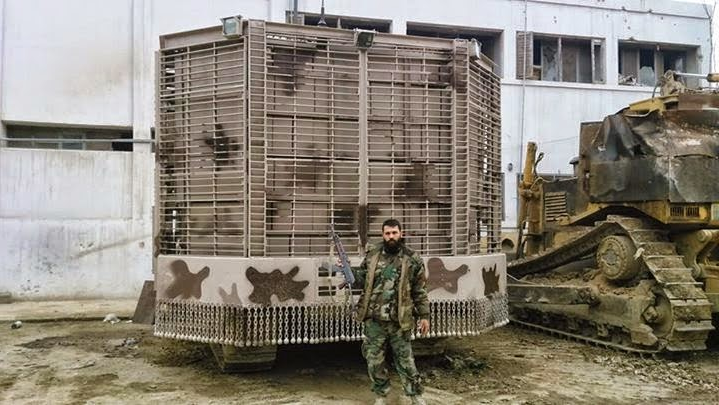
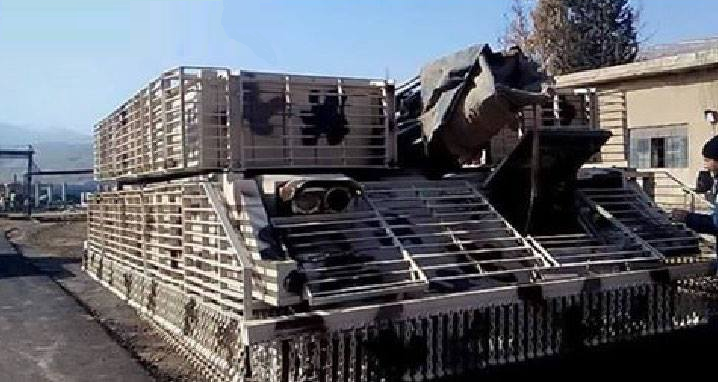
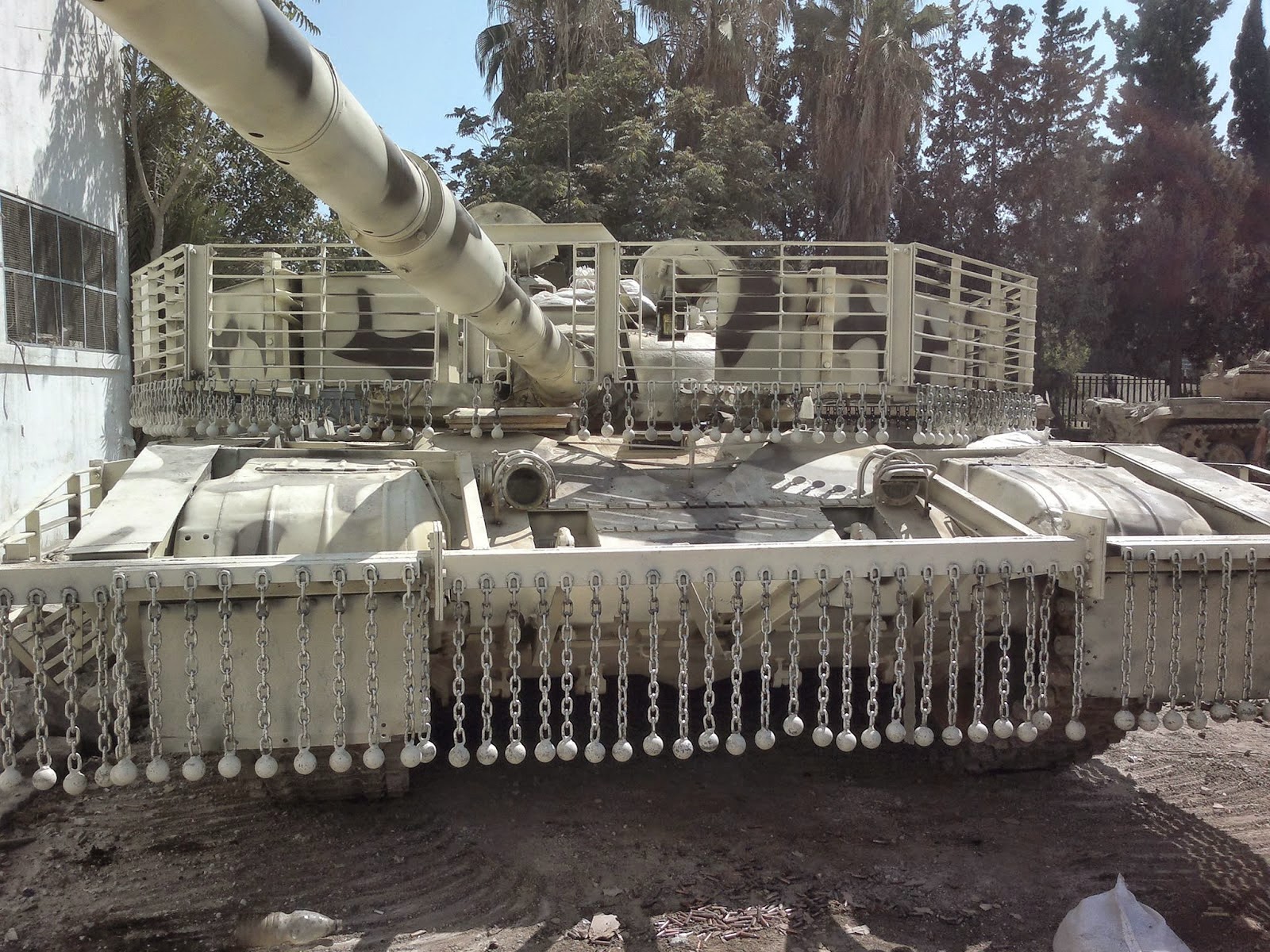


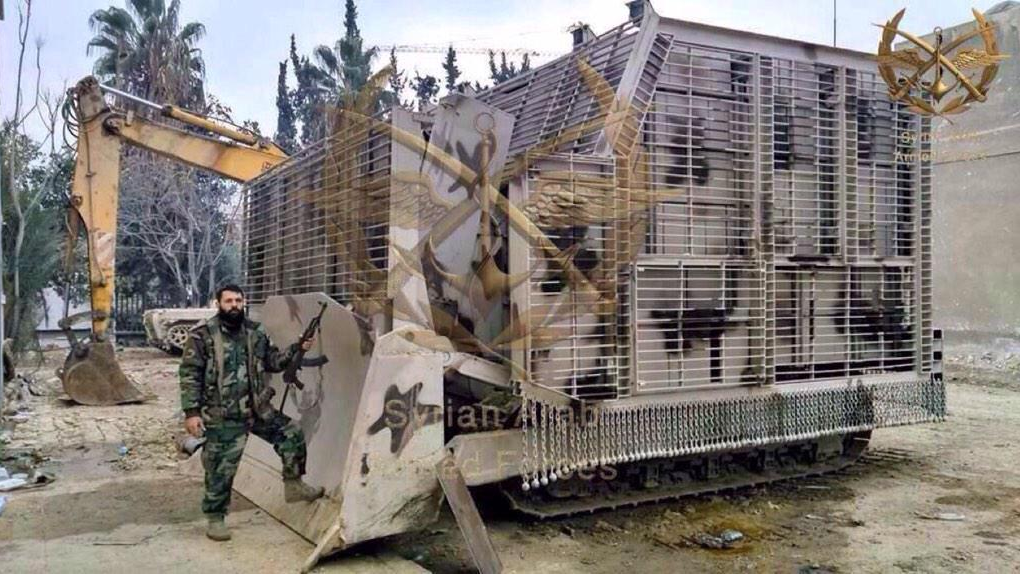
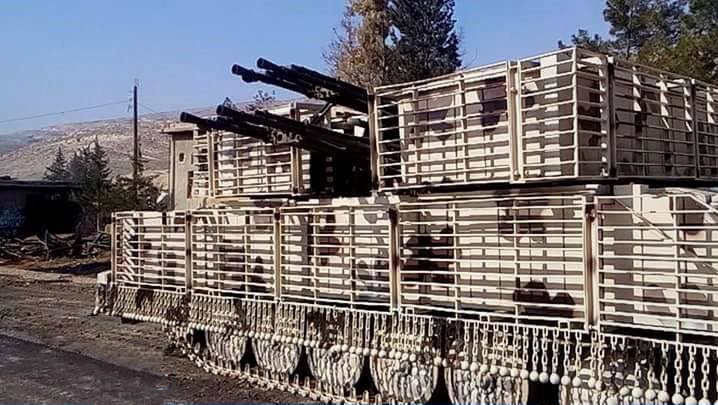








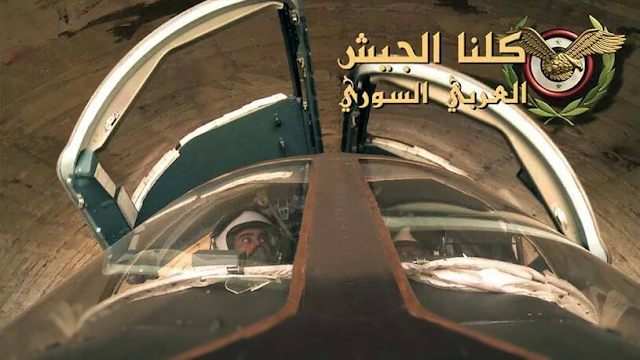































































































































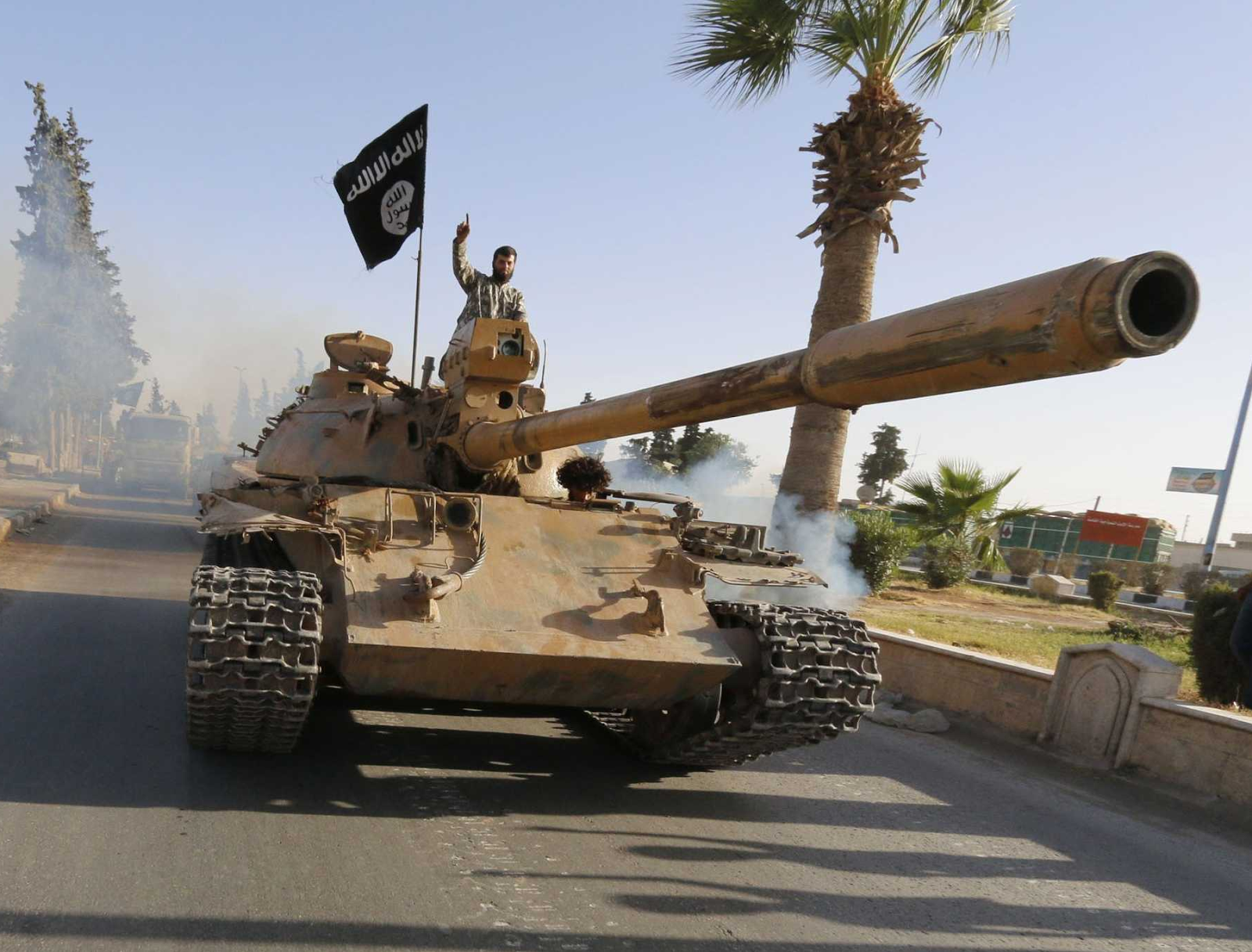
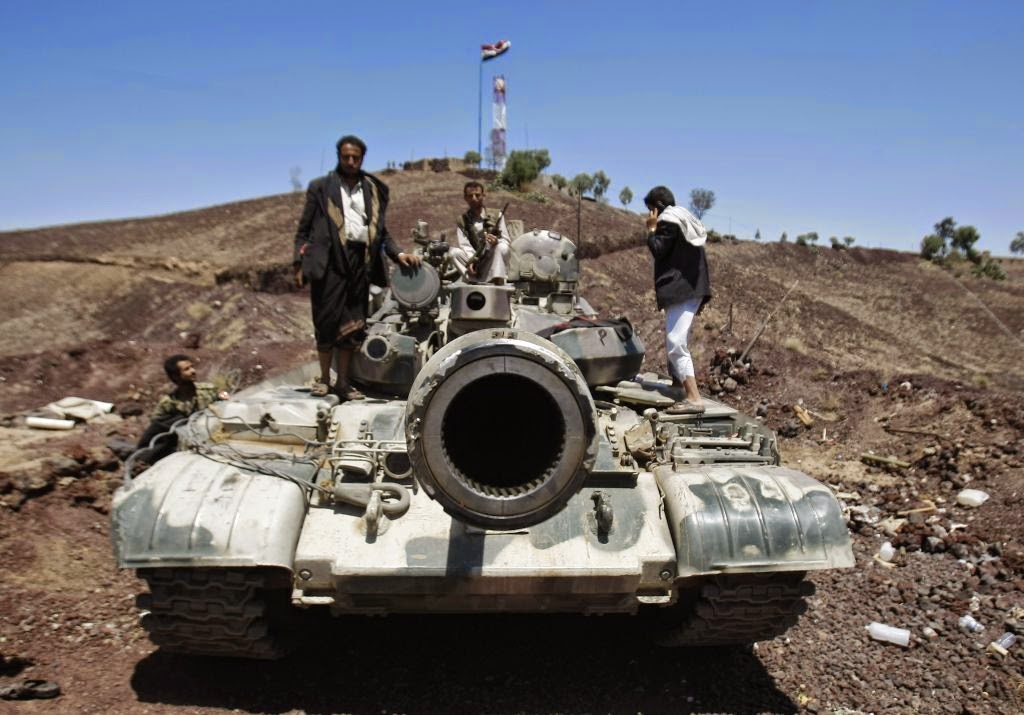























































































































































































 Sterkh-BM
Sterkh-BM 













